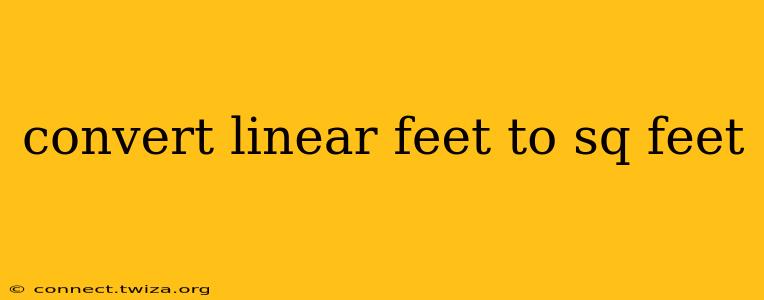Converting Linear Feet to Square Feet: Understanding the Difference
Linear feet and square feet measure different things, a common point of confusion for many DIYers and home improvement enthusiasts. Linear feet measure length, while square feet measure area. You can't directly convert linear feet to square feet without additional information. Think of it like this: linear feet tell you how long a piece of wood is, while square feet tell you how much area that piece of wood covers.
To understand the conversion, we need to consider the width of the material. Let's break down how to make this calculation and address some common questions.
How to Convert Linear Feet to Square Feet
The formula for converting linear feet to square feet is straightforward:
Square Feet = Linear Feet x Width (in feet)
Example:
Let's say you have a piece of wood that is 10 linear feet long and 1 foot wide. To find the square footage, you would perform the following calculation:
Square Feet = 10 linear feet x 1 foot = 10 square feet
What if my material isn't one foot wide?
If your material has a different width, simply substitute that width into the formula. Remember to always convert the width to feet if it's given in inches or another unit. For example:
-
Material is 12 linear feet long and 6 inches wide: First, convert 6 inches to feet (6 inches / 12 inches/foot = 0.5 feet). Then, calculate: Square Feet = 12 linear feet x 0.5 feet = 6 square feet.
-
Material is 8 linear feet long and 2.5 feet wide: Square Feet = 8 linear feet x 2.5 feet = 20 square feet.
Why can't I just convert linear feet to square feet directly?
You can't directly convert because linear feet only represent one dimension (length), while square feet represent two dimensions (length and width). The area (square footage) depends entirely on both dimensions. Think of it like trying to determine the area of a rectangle knowing only its length; you also need the width.
What are some common applications of this conversion?
This conversion is crucial in many scenarios:
-
Calculating flooring needs: You need the square footage of your room to determine how much flooring to buy. Measure the linear feet of each wall, and the width of the room to calculate the total square footage.
-
Estimating paint requirements: You’ll need to calculate the wall's square footage to determine how much paint to buy. Measure the linear feet of each wall and its height to figure out the square footage.
-
Determining the amount of material for a project: Whether it's tiling, carpeting, or laying sod, understanding square footage is essential for accurate material estimations.
-
Understanding lumber costs: Lumber is often sold by linear feet. Knowing the width allows you to determine the square footage and calculate the material costs accurately.
What if I'm dealing with irregular shapes?
For irregular shapes, calculating the square footage becomes more complex. You might need to break the shape down into smaller, more manageable rectangles or triangles, calculate the area of each, and then sum them up to find the total square footage.
This guide clarifies the process of converting linear feet to square feet, a vital skill for various home improvement and construction projects. Understanding the difference between linear and square measurements is key to accurate planning and material estimations, saving you time, money, and potential headaches.
